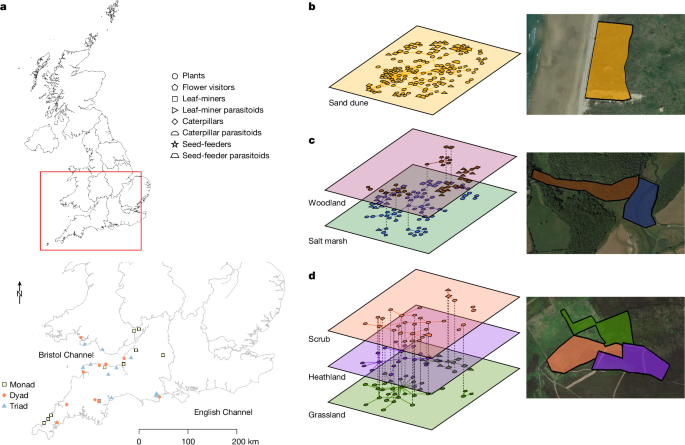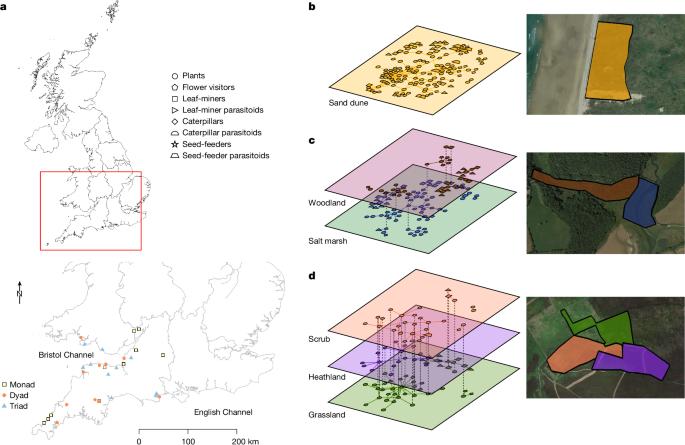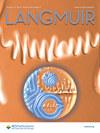Multi-habitat landscapes are more diverse and stable with improved function
IF 3.7
2区 化学
Q2 CHEMISTRY, MULTIDISCIPLINARY
引用次数: 0
Abstract
Conservation, restoration and land management are increasingly implemented at landscape scales1,2. However, because species interaction data are typically habitat- and/or guild-specific, exactly how those interactions connect habitats and affect the stability and function of communities at landscape scales remains poorly understood. We combine multi-guild species interaction data (plant–pollinator and three plant–herbivore–parasitoid communities, collected from landscapes with one, two or three habitats), a field experiment and a modelling approach to show that multi-habitat landscapes support higher species and interaction evenness, more complementary species interactions and more consistent robustness to species loss. These emergent network properties drive improved pollination success in landscapes with more habitats and are not explained by simply summing component habitat webs. Linking landscape composition, through community structure, to ecosystem function, highlights mechanisms by which several contiguous habitats can support landscape-scale ecosystem services. Species interaction data, a field experiment and modelling of plant–insect communities show that landscapes with more habitat types support more even species, more complementary interactions, are more consistently robust to species loss, and confer greater pollination function.


多生境景观更加多样和稳定,功能得到改善
保护、恢复和土地管理越来越多地在景观尺度上进行1,2。然而,由于物种相互作用数据通常是针对特定生境和/或类群的,因此人们对这些相互作用如何在景观尺度上连接生境并影响群落的稳定性和功能仍然知之甚少。我们将多行会物种互作数据(植物-传粉昆虫和三种植物-食草动物-寄生虫群落,从具有一个、两个或三个栖息地的景观中收集)、野外实验和建模方法结合起来,证明多栖息地景观支持更高的物种和互作均匀度、更多的互补物种互作以及对物种损失更一致的稳健性。这些新出现的网络特性促使更多栖息地的景观提高了授粉成功率,而这些特性并不能通过简单地将各组成部分的栖息地网络相加来解释。通过群落结构将景观组成与生态系统功能联系起来,突出了多个连续栖息地支持景观尺度生态系统服务的机制。
本文章由计算机程序翻译,如有差异,请以英文原文为准。
求助全文
约1分钟内获得全文
求助全文
来源期刊

Langmuir
化学-材料科学:综合
CiteScore
6.50
自引率
10.30%
发文量
1464
审稿时长
2.1 months
期刊介绍:
Langmuir is an interdisciplinary journal publishing articles in the following subject categories:
Colloids: surfactants and self-assembly, dispersions, emulsions, foams
Interfaces: adsorption, reactions, films, forces
Biological Interfaces: biocolloids, biomolecular and biomimetic materials
Materials: nano- and mesostructured materials, polymers, gels, liquid crystals
Electrochemistry: interfacial charge transfer, charge transport, electrocatalysis, electrokinetic phenomena, bioelectrochemistry
Devices and Applications: sensors, fluidics, patterning, catalysis, photonic crystals
However, when high-impact, original work is submitted that does not fit within the above categories, decisions to accept or decline such papers will be based on one criteria: What Would Irving Do?
Langmuir ranks #2 in citations out of 136 journals in the category of Physical Chemistry with 113,157 total citations. The journal received an Impact Factor of 4.384*.
This journal is also indexed in the categories of Materials Science (ranked #1) and Multidisciplinary Chemistry (ranked #5).
 求助内容:
求助内容: 应助结果提醒方式:
应助结果提醒方式:


